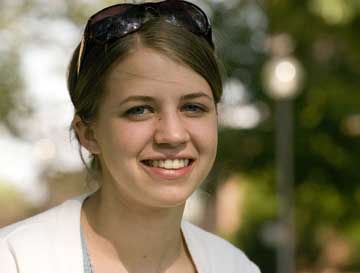Monday, August 28, 2006
College senior spends her summer researching a Mennonite poet
 GOSHEN, Ind. – Goshen College Professor of English Ann
Hostetler and Goshen College senior Sarah Roth both discovered
Mennonite poet Anna Ruth Ediger Baehr through the same poem,
“I am Dancing with My Mennonite Father,” but years
apart. In fact, Roth learned about Baehr through Hostetler’s
Mennonite poetry anthology, “A Cappella: Mennonite Voices in
Poetry.”
GOSHEN, Ind. – Goshen College Professor of English Ann
Hostetler and Goshen College senior Sarah Roth both discovered
Mennonite poet Anna Ruth Ediger Baehr through the same poem,
“I am Dancing with My Mennonite Father,” but years
apart. In fact, Roth learned about Baehr through Hostetler’s
Mennonite poetry anthology, “A Cappella: Mennonite Voices in
Poetry.”
Through the College’s Maple Scholars program, Roth has been studying this summer what it means to be a Mennonite poet and has been researching, archiving and cataloging Baehr’s papers in the Mennonite Church USA archives.
Maple Scholars is an eight-week program that gives students the opportunity to participate in independent research alongside Goshen College faculty from various disciplines. Each scholar is paired with a faculty member who works with and supervises the individual to help carry out their work. Hostetler is Roth’s adviser.
Roth, who is from Goshen, has spent much of her time categorizing the contents of over 20 boxes of Baehr’s personal papers and journals. After Baehr’s death in 1998, with Hostetler’s assistance, Baehr’s daughter donated these boxes to the Archives of the Mennonite Church USA located on the Goshen College campus. Included with these boxes are many drafts of Baehr’s poems. She has also had several unique opportunities, from attending a conference in Oklahoma for the Mennonite Mission to the Cheyenne, to interviewing Baehr’s niece, who lives in Kansas.
An English and history double major, Roth has always been drawn to poetry. “I find it a helpful way of reflecting on a traditional culture that I’m a part of. It’s founded on a personal interaction with a broader narrative,” said Roth. Reading Baehr’s poetry has “been an interesting window into the larger sketches of Mennonite history and culture.”
Hostetler said, “Sarah has taken a lot of initiative in this project, working on her own research paper, as well as organizing files for me and discovering new poems, letters and journal entries. One of the most valuable parts of the project for me is the conversations Sarah and I had about the papers, her responses to the poetry and her insights into the life and work of Anna Ruth.”
Of Baehr’s work, Hostetler, who had previously researched her in 2003, said, “Her best poems are rooted in the concrete world and precise imagery – such as cleaning the cistern, confronting a bull, refusing to pray when her father demanded she should, and following the smoke of Indian campfires along a red Oklahoma creek. Her poems honestly explore her experiences as a girl, mother, wife, and as a thinking, creative being who strove to create meaning from her life. Most of all she created a voice for articulating what many have felt but few women of her generation have expressed.”
Baehr actually did not start writing until she was in retirement, in her late 60s. Born in 1916, she spent the first 18 years of her life in Oklahoma among the Cheyenne Indians, as her parents were Mennonite missionaries. “She was kind of removed from the traditional Mennonite culture,” said Roth. Attending Bethel College for three years, she left in 1938 and married Carl Baehr. They lived in Long Island, N.Y., where Baehr became a teacher, and had to support the family once her husband lost his eyesight.
“After retirement, she did what she had always wanted to do,” said Roth, “Anna started to research, explore her past. She loved stories from the Cheyenne and from mythology. She read feminist and Mennonite theology.” Baehr’s “I Am Dancing With My Mennonite Father” was published in “The American Scholar,” a publication of the Phi Beta Kappa association, in 1985, where Hostetler found her. The poem would win the magazine’s Mary Elinore Smith prize, for the best poem published during the calendar year. Baehr died in 1998.
Both Roth and Hostetler plan to continue studying Baehr together in the coming year. Hostetler hopes to write a collective book on Baehr that collects her poems about her spiritual journey, her relationship with the Cheyenne, as well as a lengthy autobiographical essay she wrote. It will also include critical and biographical essays about her. Roth hopes to use her research from this summer for her senior history thesis.
– By Megan Blank ’07
Editors: For more information about this release, to arrange an interview or request a photo, contact Goshen College News Bureau Director Jodi H. Beyeler at (574) 535-7572 or jodihb@goshen.edu.
###
Goshen College, established in 1894, is a four-year residential Christian liberal arts college rooted in the Anabaptist-Mennonite tradition. The college’s Christ-centered core values – passionate learning, global citizenship, compassionate peacemaking and servant-leadership – prepare students as leaders for the church and world. Recognized for its unique Study-Service Term program, Goshen has earned citations of excellence in Barron’s Best Buys in Education, “Colleges of Distinction,” “Making a Difference College Guide” and U.S.News & World Report’s “America’s Best Colleges” edition, which named Goshen a “least debt college.” Visit www.goshen.edu.

 E-mail this story
E-mail this story